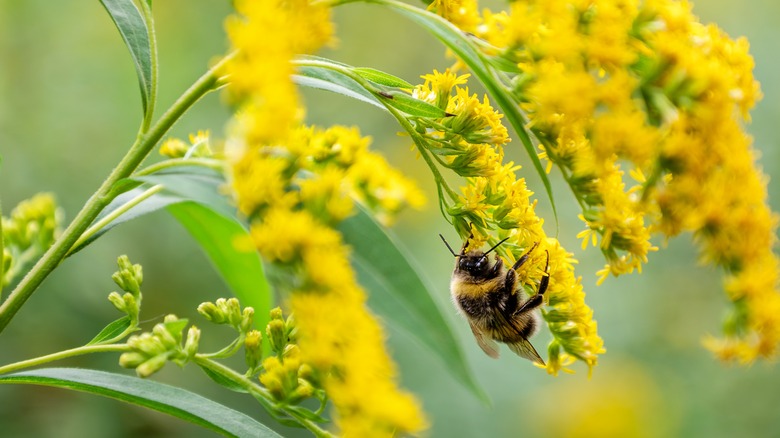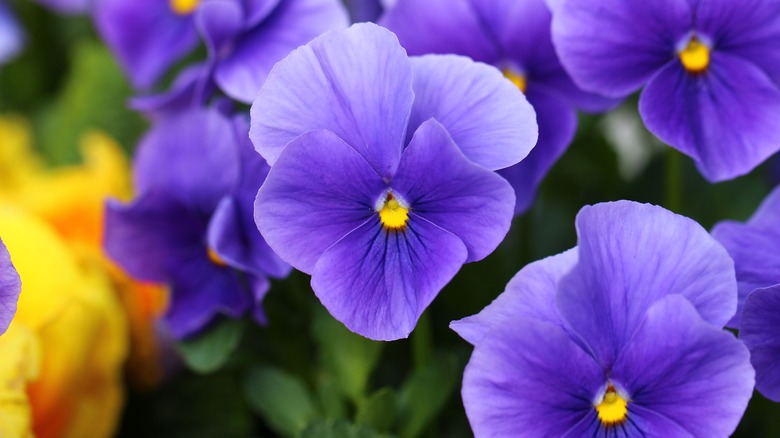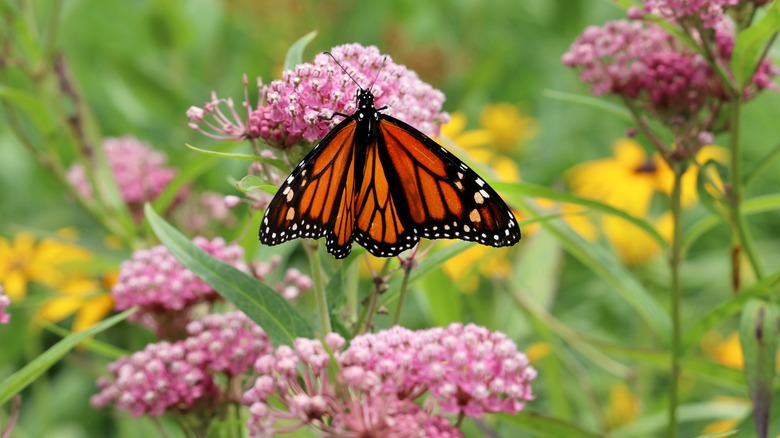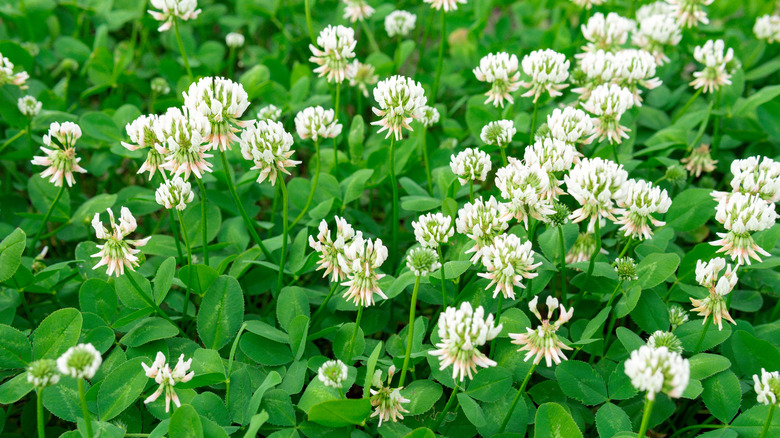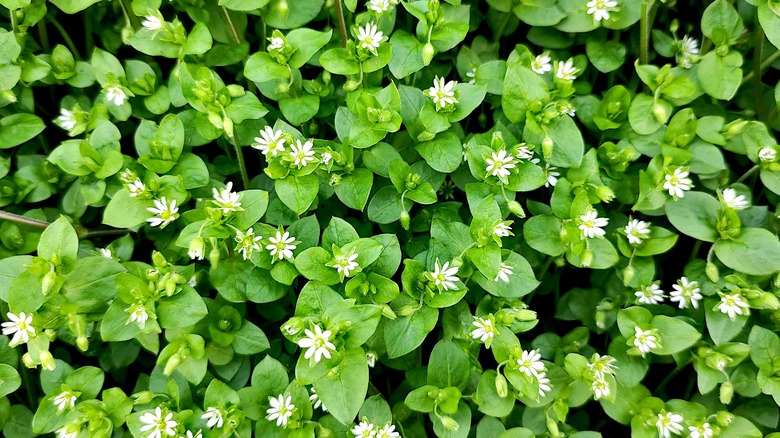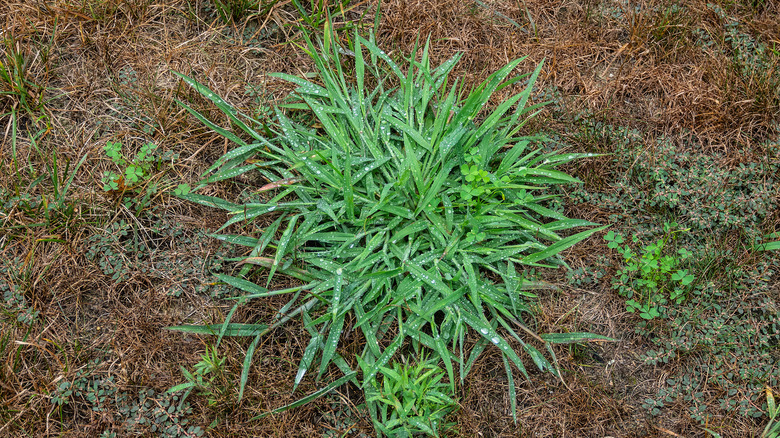Weeds You Shouldn't Pull From Your Garden
If you are a longtime gardener, the idea of weeds may fill you with feelings of annoyance, exhaustion, and dread. This is because many garden weeds not only require hours of back-breaking work to get rid of but some species of these unwanted plants are also fast-growing prolific spreaders that can make you question why you started gardening in the first place (like the tree of heaven or creeping bellflower). However, not all plants that are widely considered to be weeds are all that bad. In fact, there are some common weeds that you may want to think about keeping because they can add value to your garden and kitchen.
Of course, whether or not you decide to pull a weed depends entirely on your specific yard and garden as well as your personal preferences, but it does pay to consider the benefits of certain plants before banishing them from your yard entirely. This is especially important because weeding often targets native plants and reduces their number in preference for non-native garden plants like vegetables and exotic flowers. These non-native plants look more manicured and controlled but don't provide good food sources for local wildlife or pollinators. So, with all that in mind, here are some "weeds" that you should think twice before pulling.
Dandelions and violets are edible flowers
First on the list are two plants that are good to keep, not only for their aesthetic value but also because of their use in the kitchen. In fact, the leaves of young dandelions (with yellow flowers) can be eaten raw in fresh salads or even sauteed and fried. On top of this, dandelion flowers can be steeped in hot water to create a light and refreshing nutrient-rich tea. Dandelion tea is believed to have numerous health benefits, from promoting weight loss to soothing digestive problems.
If you are a baker, you probably already know that edible flowers are the perfect finishing touch to a lightly glazed cake or loaf of lemon bread. When it comes to decorative edible flowers, nothing looks as appetizing as violets. Whether candied or fresh, violets are a great addition to the top of any baked good with a light and sweet flavor. And if you aren't a baker, no worries. You can also top a fresh salad with violets or infuse honey, syrup, vinegar, or oil with the rich-colored flowers for a little extra creativity and holistic medicine in the kitchen. Violets have a long history of being used for medicinal purposes, whether as part of a cough syrup or healing salve.
Goldenrod and milkweed are a pollinator's best friend
There's been a lot of talk over the last few years about the need to protect our pollinators because they perform such an important role in the ecosystem. One great way to help protect native pollinators, from bumble bees to butterflies, is not to pull wildflowers.
This is especially important for butterflies because, while adult butterflies may enjoy the nectar of non-native plants, exotic garden flowers are not appropriate food for caterpillars. This means that having only non-indigenous plants like butterfly bushes in your garden can cause butterflies to find food but be unable to lay their eggs. So, instead, go for a mix of exotic flowers and native flowers like goldenrod (which is loved by multiple types of native moths). Or, if you want to have gorgeous monarch butterflies in your yard, then keep your milkweed — the only plant that monarch larvae can consume and often where adult butterflies lay their eggs.
Keeping wildflowers like goldenrod or milkweed will not only benefit the environment but will bring further benefit to your garden by attracting more pollinating insects that will also visit your vegetables and flowers to bring a better harvest and bloom.
White clover and broadleaf plantain act as soil fertilizers
White clover and broadleaf plantain are two of the most common weeds that are found in lawns across the United States. While they are often considered to be nuisances that interfere with the growth of grass, there is one major reason you may want to keep them in your yard: they can help improve soil quality.
For clover, this happens because the plant tends to grow in areas that are already lacking nutrients. Then, this quick-spreading plant actively revitalizes the unhealthy soil by pulling nitrogen from the air and storing it in its roots, thereby adding it back into the earth around it. Furthermore, clover (when allowed to grow and flower) also attracts and supports important pollinators.
Broadleaf plantain (a plant you've probably seen in your yard but never knew what it was called) can also help improve your soil by gathering essential nutrients like magnesium, sulfur, and calcium. Then, when the plant dies in the winter, those nutrients are reabsorbed into the soil as the leaves decompose. The best thing about broadleaf plantain is if you decide there are too many in your yard, you can always harvest the leaves and add them to a fresh salad because the entire plant is edible and packed with nutrients.
Chickweed and burdock are herbal healers
While many of the "weeds" on this list have been used historically for their medicinal values, none of them have been used as extensively as chickweed and burdock. Chickweed has long been a favorite of herbal healers around the world and was even recommended in ancient Greece as a way to treat inflammation. While today there are no clinical studies that prove that chickweed has healing properties, some preliminary research suggests that chickweed tea may have health benefits, including aiding in weight loss, reducing inflammation, and loosening mucus when congested. Chickweed salve can also help soothe itchy or irritated skin.
Burdock is an important staple in traditional Chinese medicine and is commonly used to get rid of toxins in the blood. Burdock root can be steeped to make tea or ground into a powder and then turned into a skin salve to treat acne or eczema. The only controversial aspect of keeping burdock in your yard is that it is considered an invasive plant in most of the United States and can quickly spread to take over a garden. So, if you do decide not to pull burdock, it is important to keep an eye on it and mow over or kill any plants that are growing outside of their designated area.
Types of weeds that should always be pulled
Now that we have discussed some weeds that can have beneficial properties for the environment, your garden, and your health. It's important to know and be able to recognize weeds have no benefits and are actively harmful. This category includes obvious contenders like poison ivy and poison oak as well as more hard-to-identify plants like poison hemlock — an invasive plant that can be deadly if consumed by humans or animals but looks remarkably similar to the non-poisonous Queen Anne's lace (also known as wild carrot).
Furthermore, certain native wildflowers produce a lot of pollen and you may want to pull them if you or a family member suffers from seasonal allergies. Some of these include ragweed (often confused for goldenrod), amaranth (sometimes called pigweed), daisies, sagebrush, and tumbleweed. Other weeds should be removed because they are prolific spreaders that tend to take over yards and gardens, making it hard for your desired plants to thrive. Some of these weeds include crabgrass, buckthorn, bindweed, and creeping charlie.
